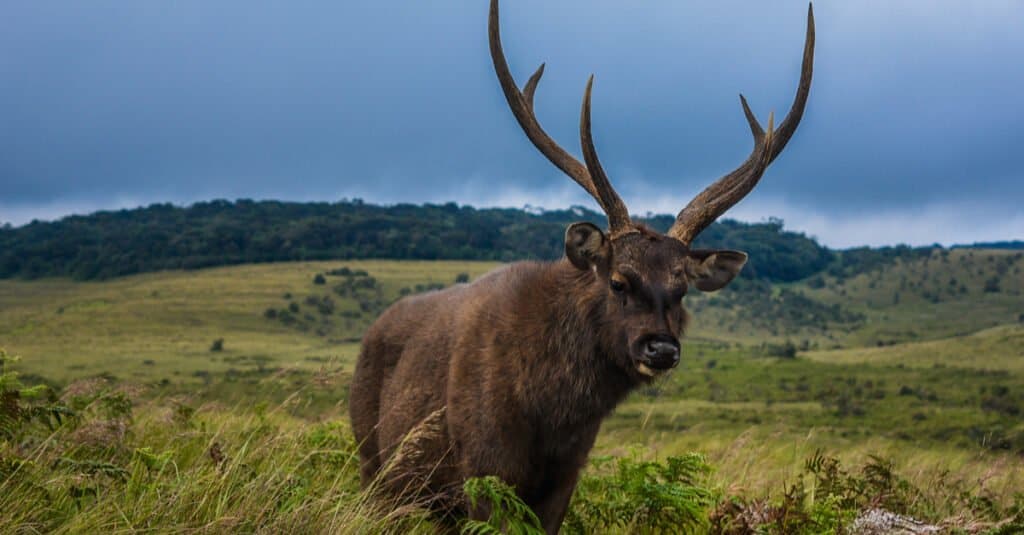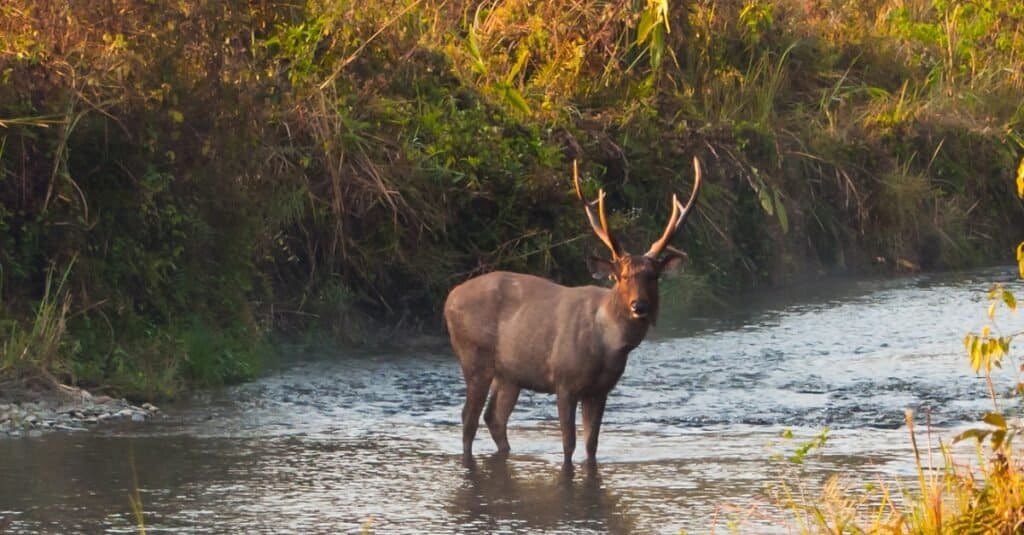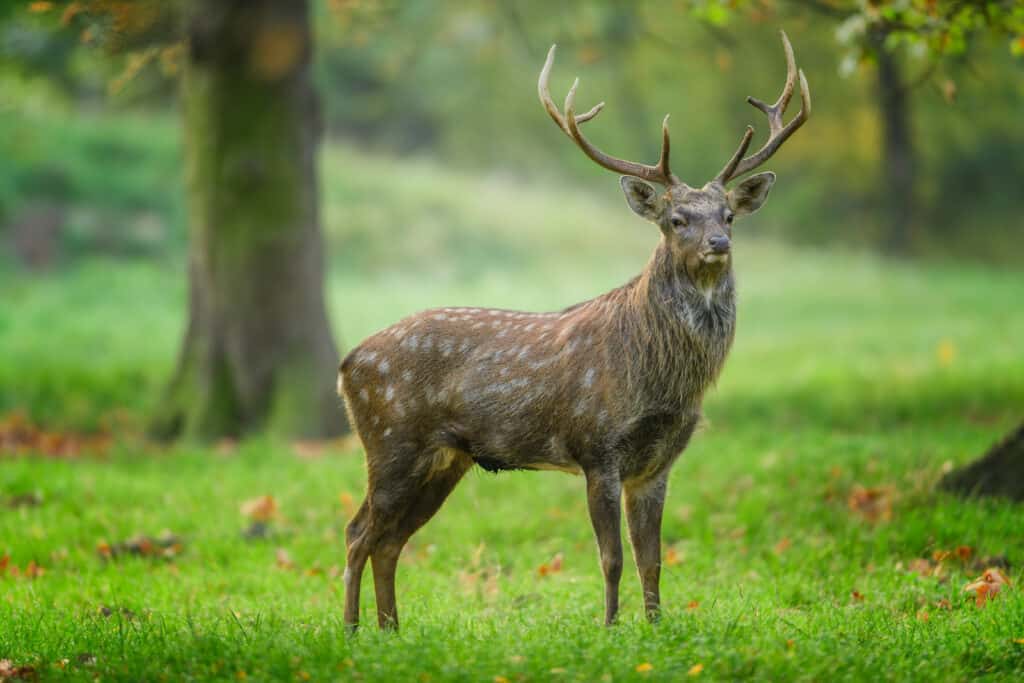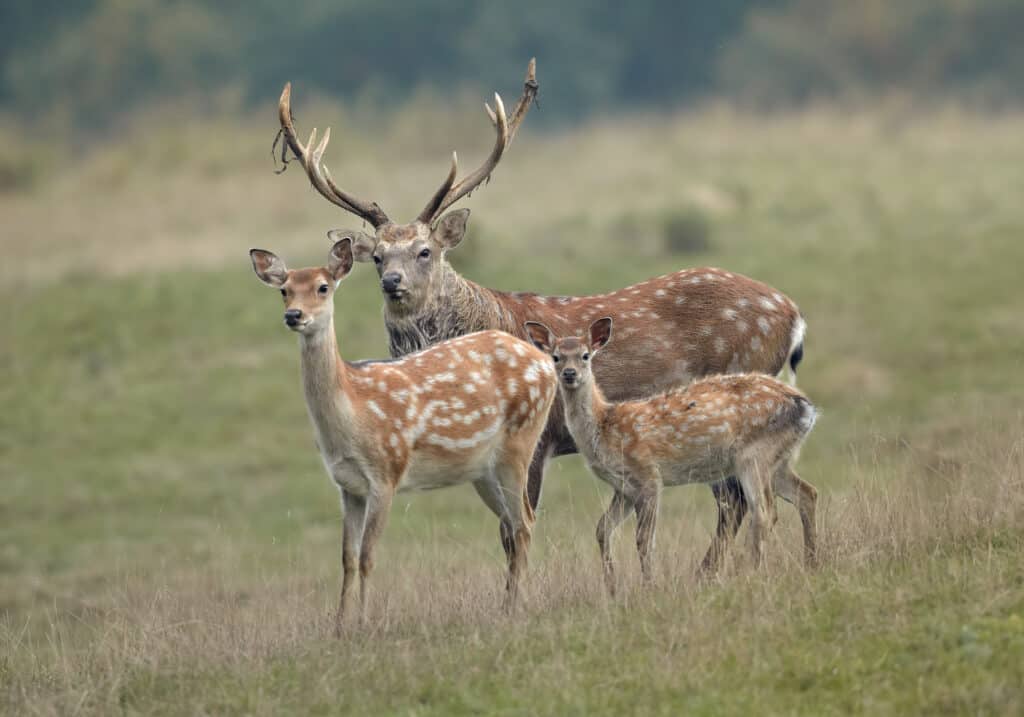Many species of deer can be found across the world, and it can be difficult to tell them apart. That is not the case with the sambar deer and the sika deer since they are two distinct species, but it’s always worth knowing how unique species of deer can be. Today, we’re going to compare the sambar deer vs. the sika deer and demonstrate several different qualities that make them stand out from each other.
Comparing a Sambar Deer and a Sika Deer

Sambar deer weigh between 240 and 1,200 lbs, stand between 4 and 5 feet tall, and measure between 5 and 8.9 feet long.
©Swarna367/Shutterstock.com
| Sambar Deer | Sika Deer | |
|---|---|---|
| Size | Weight: 240-1,200 lbs Height: 4-5 ft Length: 5-8.9 ft | Weight: 75-140 lbs and possibly more Height: 2-2.5 ft Length: 3-4.5 ft |
| Morphology | – Heavily built body and thin legs – Amber or yellow-brown coat that turns to a deep gray – Black tail with a light underside – May grow a thin mane in fall and winter – Large antlers that measure up to 3.5 ft in length | – Has tan or light brown fur with a light color on the underside – May have a very dark brown or almost black coat – Has white spots on its fur that continue to exist even when the deer has become mature – Males grow a mane in the winter – Antlers range in size, up to 2.5 ft |
| Species | – Rusa unicolor – Several subspecies | – Cervus nippon – Crossbreeds with other species – Several subspecies |
| Range | – Indian subcontinent – Southeast Asia – Burma, Taiwan, south China, Thailand, Malaysia, and more – Introduced to some places like Australia and Florida – Prefers to live in tropical forests, tropical rainforests, and grasslands – Prefers to live near water | – Once lived in eastern Asia – Lived in Russia, Vietnam, Japan, China, and other areas – Have been introduced to other parts of the world including the U.S., Europe, and New Zealand. |
| Social Interactions | – Males mostly live alone – Females and young may live together in groups of up to a dozen or more | – Males, or stags, live mostly alone in the fall and winter – Males may also live in bachelor groups in the spring and summer – Females usually live in small bands with their young and juveniles born in a previous year |
The Key Differences Between a Sambar Deer vs. Sika Deer
The greatest differences between a sambar deer and a sika deer lie in their size and coloration. Sika deer are very small compared to the large sambar deer, weighing between 70 and 140 pounds on average, while a sambar deer can regularly weigh over 500 pounds.
Also, the sambar deer is taller and longer than the sika deer, measuring up to 5 feet tall and 8.9 feet long, while the sika deer only stands about 2.5 feet tall and measures about 4.5 feet long. The coloration of the sambar deer is yellow-brown or amber, but the sika deer has a tan, light brown, dark brown, or nearly black coat.
These differences in color and size are two of the most obvious distinctions, but they are hardly the only important ones. Let’s continue to look at how sambar deer and sika deer may be contrasted.
Sambar Deer vs. Sika Deer: Size

Sika deer typically stand between 2 and 2.5 feet tall and grow between 3 and 4.5 feet in length.
©iStock.com/Elena Tcykina
The sambar deer is far larger than the sika deer. Sambar deer weigh between 240 and 1,200 lbs, stand between 4 and 5 feet tall, and measure between 5 and 8.9 feet long.
However, the sika deer is far smaller, weighing up to 140 pounds on average, with some subspecies weighing 200 pounds or more. Also, they typically stand between 2 and 2.5 feet tall and grow between 3 and 4.5 feet in length. The sambar deer would be an imposing figure next to a sika deer.
Sambar Deer vs. Sika Deer: Morphology

Sambar deer antlers can measure upwards of 3.5 feet in length
©iStock.com/neelsky
The sika deer and sambar deer have many differences in their color, antlers, tails, and other morphological features. The sambar deer has a coat of hair that is amber or yellow-brown, and that coat becomes a deep gray color in the winter season. Yet, the sika deer can have a light brown, tan, dark brown, or almost black coat.
The sika deer is one of the few species that retains its spots after it matures. Like the sambar deer, they grow a mane in the winter. They have tails that vary in coloration, but it’s common for them to have a light-colored tail with a dark stripe running down the middle. Sambar deer have a black tail with a light underside.
Sambar deer also have far larger antlers than the sika deer. Their antlers can measure upwards of 3.5 feet in length, but a sika deer’s antlers will usually top out at 2.5 feet long.
Sambar Deer vs. Sika Deer: Species

The sika deer is known to crossbreed with other species.
©miroslav chytil/Shutterstock.com
The sambar deer and sika deer are members of the same phylogenetic family. However, they come from different species. The sika deer is Cervus nippon, and the sambar deer is Rusa unicolor. Both species have numerous subspecies, and the sika deer is even known to crossbreed with other species.
Sambar Deer vs. Sika Deer: Range

The sambar deer can be found in Australia and Florida within the U.S.
©Signature Message/Shutterstock.com
The sambar deer and the sika deer have ranges in different parts of Asia. You’ll find the sambar deer from the Indian subcontinent to Southeast Asia in countries like India. Taiwan, China, Malaysia, and more. On the other hand, the sika deer has a limited population in eastern Asia in countries like Vietnam, Russia, China, and Japan. However, the sika deer is rare in all those countries but Japan.
Both species have been introduced to other parts of the world, though. The sambar deer can be found in Australia and Florida within the U.S. Meanwhile, sika deer have also been transported to the Northeast in the U.S., Europe, and New Zealand.
Sambar Deer vs. Sika Deer: Social Interactions

The sika deer has a limited population in eastern Asia in countries like Vietnam, Russia, China, and Japan.
©Martin Mecnarowski/Shutterstock.com
The sika deer and sambar deer have rather similar social interactions. The males mostly live alone in the fall and winter. Sika deer may join bachelor groups in the spring and summer, though. The females of both species live in groups with other females and young deer. Sika deer live in small bands, but female sambar deer and young offspring may live in groups of a dozen or more for safety purposes.
The sambar deer and sika deer are difficult to mistake for each other. Although they may have some areas that overlap in their range, their size disparity, coloration, and other elements of their morphology set the two creatures apart.
Up Next:
The photo featured at the top of this post is ©
Sources
- The University of Edinburgh, Available here: https://www.ed.ac.uk/news/all-news/red-deer-280109
- Maryland.gov., Available here: https://dnr.maryland.gov/wildlife/Pages/plants_wildlife/SikaDeer.aspx
- Science Direct, Available here: https://www.sciencedirect.com/science/article/abs/pii/S0378432020305029
- The Wildlife Trusts, Available here: https://www.wildlifetrusts.org/wildlife-explorer/mammals/red-deer
Thank you for reading! Have some feedback for us? Contact the AZ Animals editorial team.






